Reuse Water in Juice Plant
Reuse water ability in a new treatment system was needed in a juice processing company for other plant processes. The high strength wastewater, with a COD of 16,000mg/L, needed to meet stringent effluent criteria to make this possible.
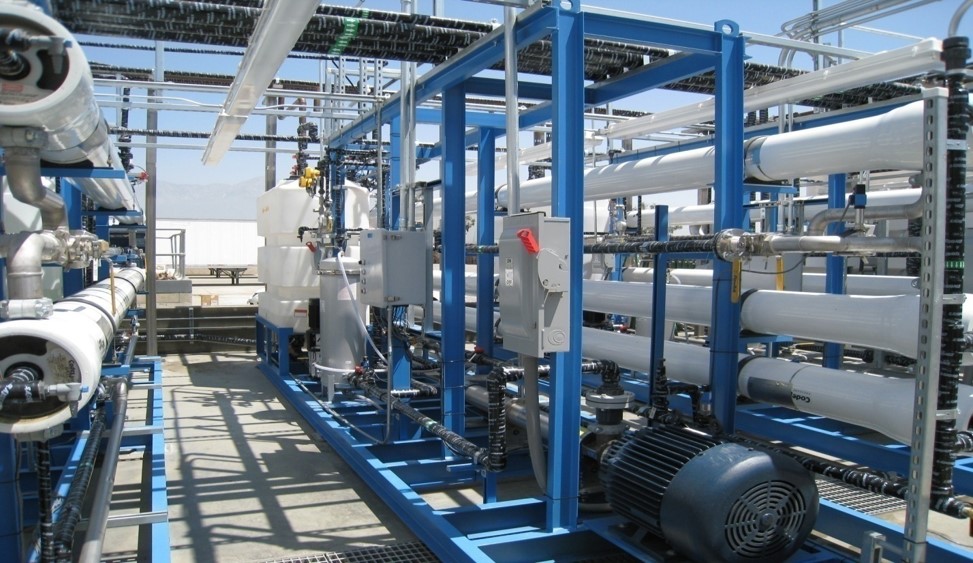
Reuse water in juice plant
The solution, provided by Dynatec, includes a membrane bioreactor (MBR) followed by a double pass reverse osmosis (RO) system. The permeate meets all limits for BOD, COD, metals, TSS, and TDS.
Reuse water systems have been provided by Dynatec Systems to many industries. The ability to recover and reuse water has many benefits.
- Saving on water costs
- Saving on wastewater disposal charges
- Decreased environmental impact
- Protection from regulatory changes
- Decrease dependence on water provider/source
- Ability to expand without affecting water demand
- Overcome water scarcity issues
- Consistently high-quality for water reuse
Ultrafiltration (UF), Membrane Bioreactor (MBR), Nanofiltration (NF) and Reverse Osmosis (RO) are employed by Dynatec for water reuse projects. Water recovery and water reuse has been successfully implemented with industrial and sanitary wastewater streams for:
- Cooling tower make up
- Boiler feed
- Irrigation
- Toilet flushing
- Direct potable reuse
- Cleaning/wash applications
- Rinse processes
- Painting processes
- Other plant processes
Reuse water systems provided by Dynatec Systems:
- Resorts, hotels, and retirement homes
- Golf courses
- Automotive companies
- Food and beverage companies
- Apartment buildings
- Landfills
- Mines
- Metal finishing plants
- Aerospace companies
For more information, please contact us today.
https://www.dynatecsystems.com/technologies/recovery-and-reuse/
Anaerobic digester and aerobic MBR followed by RO for whiskey manufacturer
Anaerobic digester and aerobic MBR followed by RO provided by Dynatec Systems. A whiskey manufacturer needed a wastewater treatment system to reduce very high organic content BOD and COD. As well as, solids content TSS of the wastewater stillage to achieve the demanding final treated water discharge standards. A membrane filter is used for pretreatment prior to the anaerobic system. The tubular membrane filter employed with the biological system is not dependent on the settling characteristics and produces very high-quality effluent.
The equipment was containerized to make the implementation as easy as possible.
Membrane bioreactors offer a unique and effective solution for the treatment and reuse of industrial wastewater in industries such as landfills, automotive, aerostructures, distilleries and dairies. Our industry-leading designs and innovation also deliver superior performance for sanitary wastewater and biological nutrient removal applications.
The MBR configuration has proven to be optimal for treatment of many industrial wastewaters when treatment efficiency is an important consideration.
The MBR is the ideal bioreactor configuration for treatment of organic or inorganic contaminants present in industrial wastewaters. MBRs operate at a higher efficiency while achieving consistent design performance objectives. This makes MBR a more cost effective method of treatment when performance and tank requirements are considered.
Bioreactor systems such as the conventional activated sludge system, sequencing batch reactor system and trickling filters are typically designed for operation at a lower volumetric removal rate, requiring larger tanks and more space. These conventional systems often experience upsets that inhibit settling and therefore require much more operator attention than a membrane bioreactor.
The MBR has proven to be optimal for treatment of many industrial wastewaters because it is less susceptible to upsets. The MBR’s performance is not affected by changes in sludge settleability like the conventional systems, making MBR a wise choice for industrial systems that have more difficult to treat waste streams. Dynatec has over 42 years experience in dealing with difficult to treat industrial wastewaters using membrane filtration.
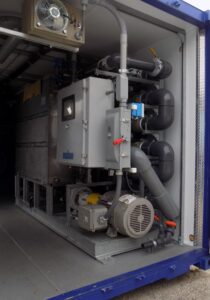
For more information on anaerobic digester and aerobic membrane bioreactor followed by reverse osmosis, please contact us today.
https://www.dynatecsystems.com/technologies/membrane-bioreactors/mbr-conversion-r…pgrade-solutions/
Landfill Leachate Treatment Expansion
Dynatec supplied two new Ultrafiltration systems for a landfill leachate treatment expansion project. These skids are part of an expansion at an existing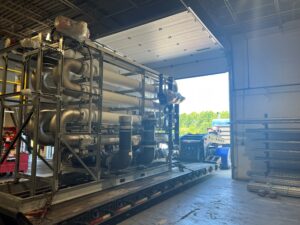 leachate treatment plant. The existing Dynatec system treats 250,000 gallons per day. This expansion will allow them to filter 500,000gpd on average. The primary target contaminants at the landfill are heavy metals. The existing UF system has allowed the landfill to successfully reach their discharge limits for metals. Due to this success, they have contracted Dynatec as the leachate production has increased.
leachate treatment plant. The existing Dynatec system treats 250,000 gallons per day. This expansion will allow them to filter 500,000gpd on average. The primary target contaminants at the landfill are heavy metals. The existing UF system has allowed the landfill to successfully reach their discharge limits for metals. Due to this success, they have contracted Dynatec as the leachate production has increased.
Dynatec Systems industry-leading tubular ultrafiltration (UF) system is used to treat a broad range of industrial wastewater by separating insoluble components from waste streams. As a cost effective and simple solution for separating insoluble components and colloidal contaminants from a waste stream, wastewater UF offers significant advantages over conventional separation. It is a useful process that does not require chemicals or much space to separate insoluble contaminants.
UF is a pressure-driven process that removes the following from wastewater and other solutions:
- Emulsified oils
- Metal hydroxides
- Colloids
- Emulsions
- Dispersed material
- Suspended solids
- Other large molecular-weight materials
Ultrafiltration systems are also capable of concentrating:
- Bacteria
- Some proteins
- Some dyes
- Colloidal or emulsified components
Ultrafiltration systems excels at the clarification of solutions containing:
- Suspended solids
- Bacteria
- High concentrations of macromolecules including:
- Oil and water
- Fruit juice
- Milk
- Whey
- Electro-coat paints
- Pharmaceuticals
- Poly-vinyl alcohol and indigo
- Potable water
- Tertiary wastewater
Ultrafiltration offers the following advantages over conventional separation:
- No chemical required
- Very little labor required
- Simple mechanical process
- Less sludge
- Ability to concentrate the retentate for beneficial use
- Less space required
- Overall lower operating costs
Tubular Configuration:
- Higher permeate rate
- Lower rates of fouling
- Higher concentration of retentate
- Easier to clean
- Longer membrane life
- Low operating cost
https://www.dynatecsystems.com/industries/landfill-leachate-treatment/
Contact Dynatec for your landfill leachate treatment solution today.
Dairy Converts System to MBR
A dairy converts an existing biological system to a membrane bioreactor (MBR). The converted plant has the ability to process wastewater at the rate of 475,000 gallons per day.
The conversion provided the ability to increase the treatment rate and at the same time improve the quality of the treated water. The system operated at a higher concentration of mixed liquor in the bioreactor and thereby increase the throughput capacity of the existing bioreactor and improves the quality of the treated water (0.03 micron membrane allows less bacteria and virus to penetrate the membrane surface) that is discharged.
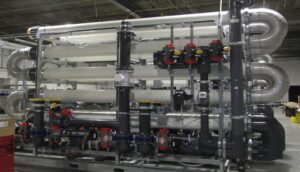
The Dynatec “out of bioreactor” membrane configuration provided for optimization of both biological and membrane systems. Dynatec’s membrane system decoupled the membrane filtration and biological treatment in a way that allowed for optimization of both the solids liquid separation and the biological system design. The system is capable of operating with MLSS as high as 25,000 mg/L and this has maximized the operator flexibility in plant operations to achieve optimum performance. The positive recirculation through the membrane system minimizes fouling and reduces operator attention.
The amount of space required for the membrane system was small and therefore the system was easily added because of the flexibility in locating the membrane system. The system did not need to be next to or close to the bioreactor. The higher system membrane flux (permeate rate) meant that fewer membranes were required. The simple design required less ancillary equipment and operation at high MLSS meant that no additional tanks were required.
Dynatec’s membrane systems draws on our many years of experience to provide a cost effective, simple system that outperforms other systems, especially with difficult to treat waste streams.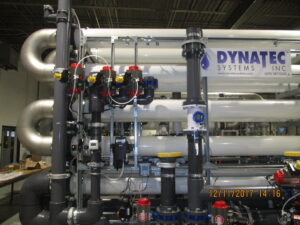
Dynatec’s membrane system was selected in part because the overall capital cost was lower than alternative solutions and because the conversion was principally centered on the addition of the membrane system which was inexpensive to install and the location did not need to be close to the existing bioreactor.
Another reason for the selection of Dynatec by the dairy converts existing system to MBR was because the membrane systems are completely enclosed which minimizes maintenance and provides a safe, clean environment for operators. The operators were not exposed to fumes and noxious gases.
The system was designed for remote access on any device with a web browser enabling the operator to review system performance and make changes without a site visit.
The unique operation of the membrane system makes it the right solution for difficult to treat wastewater applications such as dairy wastewater. The membrane system operates using tubular membranes in series with a recirculation flow that continuously scours the walls of the membrane surface. This prevents the buildup of solids on the membrane surface. The elimination of the solids buildup on the membrane surface results in high flux rates and consistent, dependable operation even in difficult applications where the solids do not filter well.
Contact Dynatec to discuss your wastewater needs.
https://www.dynatecsystems.com/technologies/membrane-bioreactors/mbr-conversion-r…pgrade-solutions/
Anaerobic MBR with Dynatec Tubular UF Membranes
Maximizing Efficiency & Sustainability in Industrial
Wastewater Treatment
Why Choose Anaerobic MBR?
Anaerobic Membrane Bioreactor (AnMBR) technology is revolutionizing industrial wastewater treatment by combining anaerobic digestion with advanced membrane filtration. This cutting-edge process enables industries to achieve superior wastewater treatment while generating biogas for energy recovery.
The Dynatec Advantage: Tubular UF Membranes Dynatec’s tubular ultrafiltration (UF) membranes are at the core of our AnMBR systems, offering unmatched performance in treating high-strength wastewater.
These membranes provide:
Superior Solids Handling –
Handles high mixed liquor suspended solids (MLSS) without frequent cleaning or fouling.
Consistent Permeate Quality –
Achieves exceptional effluent quality with low turbidity and high removal of contaminants.
Robust & Durable Design – Built to withstand challenging industrial wastewater conditions.
Minimized Maintenance – Long membrane lifespan with reduced downtime and lower operating costs.
Key Benefits of Anaerobic MBR with Dynatec UF Membranes
- Energy Generation & Cost Savings
– Converts organic matter into biogas, reducing energy costs.
– Eliminates the need for aeration, lowering power consumption significantly.
- High-Quality Effluent for Reuse or Discharge
– Produces low-BOD and TSS effluent, meeting stringent discharge limits.
– Enables water reuse for non-potable applications, reducing water demand.
- Compact Footprint & Modular Scalability
– Requires less space than conventional anaerobic treatment.
– Easily scalable to meet varying flow rates and loads.
- Low Sludge Production & Reduced Handling Costs
– Generates minimal biosolids, lowering disposal costs.
– Reduces environmental impact and regulatory burdens.
Ideal Applications
– Food & Beverage Processing
– Agriculture / Manure
– Pulp & Paper Mills
– Pharmaceutical & Chemical Industries
– Landfill Leachate Treatment
-High-Strength Industrial Wastewater
Optimize Your Wastewater Treatment Today. Leverage the power of Anaerobic MBR with Dynatec’s tubular UF membranes for a sustainable, cost-effective, and energy-efficient solution.
Contact us today to learn how our advanced wastewater treatment systems can work for you.
Color Removal with Membranes
Color Removal with Membranes
Membranes selectively remove dissolved species from a variety of sources including:
- Surface water
- Rinse water from fabric dyeing
- Industrial wastewater
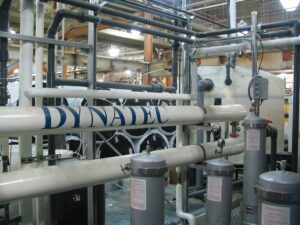 Landfill leachate
Landfill leachate
Demands for development of membranes with specific performance continue to increase as water quality requirements tighten and water treatment system designs become more complex. Such demands lead to development of new reverse osmosis (RO) and nanofiltration (NF) membranes with higher rejection characteristics for better dissolved salts and boron removal.
New applications have developed which require selective removal of certain dissolved species such as:
- hardness
- natural organic matter (NOM)
- pesticides
- Organic material which causes color
Engineers desire high removal of specific contaminants in these applications, but at the same time want to maintain some level of salts in the water so it does not become aggressive, which can cause corrosion problems with piping in the distribution network.
Nanofiltration (NF) membranes have good selectivity for removal of naturally occurring organic compounds as well as iron. Organic material can be found in groundwater sources which have surface water intrusion, or groundwater sources which are influenced by decomposing vegetative materials. The contamination of these waters is measured in terms of color units.
Treated water from landfill leachate is another source of color in wastewater. When this wastewater is discharged to a municipal treatment plant (POTW), color and the presence of certain organic acids affect the performance of the final ultraviolet treatment step, causing the receiving facility to require that these components be reduced or eliminated.
Dynatec has developed a number of options for color removal with membranes and organic acid removal. Since each project requires different levels of removal and has different treatment requirements, treatability work is typically carried out to establish the required treatment process steps. Typically, treatment requirements not only include color removal, but may also require the removal of COD, BOD, oil and grease, metals, etc. The treatment steps may include:
- metals and/or free-floating oil
- settleable materials removal
- ultrafiltration for removal of suspended colloidal materials
- nanofiltration using several options that are available, depending on the requirements of the particular application
- reverse osmosis for the removal of color, dissolved solids and organics
Finally, some color removal can be accomplished with ion exchange resins specially developed for color removal.
Dynatec will carry out treatability work at their treatment lab or will provide small-scale pilot equipment that is shipped to the project site where longer term studies can be carried out.
Contact us today to discuss your wastewater treatment needs.
www.dynatecsystems.com/industries/textile-wastewat…reatment-systems/
Ultrafiltration Removes Oil and Metals
Ultrafiltration removes oil and metals to allow the treated water to be acceptable for discharge for an automobile parts manufacturer. A UF system was selected based upon its ability to consistently meet the discharge requirements without chemicals and with limited operator involvement. This UF system removes oil and reduces zinc in compliance with discharge requirements.
Ultrafiltration excels at the clarification of solutions containing suspended solids, bacteria and high concentrations of macromolecules, including oil thus making this an excellent solution to this problem.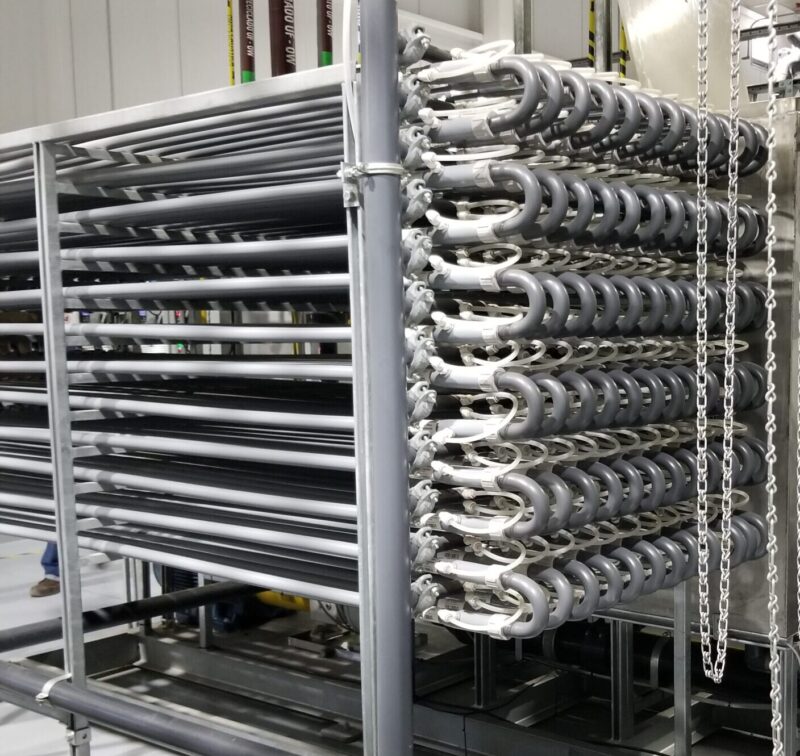
Ultrafiltration uses a membrane to separate suspended and colloidal materials in an aqueous phase. It will normally separate everything that is not soluble and some larger macro molecules that are soluble. Ultrafiltration uses a PVDF tubular membrane that is permeable to perform the separation. One of the uses that demonstrates the usefulness of ultrafiltration is separation of oil in an emulsion from water. In this case, machining coolant oil emulsions can have the oil separated and concentrated, with the water passing through the membrane, and the concentrated oil phase disposed.
Dynatec Systems industry-leading tubular ultrafiltration (UF) system is used to treat a broad range of industrial wastewater by separating insoluble components from waste streams. As a cost effective and simple solution for separating insoluble components and colloidal contaminants from a waste stream, wastewater UF offers significant advantages over conventional separation. It is a useful process that does not require chemicals or much space to separate insoluble contaminants.
UF is a pressure-driven process that removes the following from wastewater and other solutions:
- Emulsified oils
- Metal hydroxides
- Colloids
- Emulsions
- Dispersed material
- Suspended solids
- Other large molecular-weight materials
Ultrafiltration systems are also capable of concentrating:
- Bacteria
- Some proteins
- Some dyes
- Colloidal or emulsified components
Ultrafiltration systems excels at the clarification of solutions containing:
- Suspended solids
- Bacteria
- High concentrations of macromolecules including:
- Oil and water
- Fruit juice
- Milk
- Whey
- Electro-coat paints
- Pharmaceuticals
- Poly-vinyl alcohol and indigo
- Potable water
- Tertiary wastewater
Ultrafiltration offers the following advantages over conventional separation:
- No chemical required
- Very little labor required
- Simple mechanical process
- Less sludge
- Ability to concentrate the retentate for beneficial use
- Less space required
- Overall lower operating costs
Tubular Configuration:
- Higher permeate rate
- Lower rates of fouling
- Higher concentration of retentate
- Easier to clean
- Longer membrane life
- Low operating cost
For more information on ultrafiltration systems to remove oil and metals, please contact us today.
https://www.dynatecsystems.com/technologies/membrane-technologies/ultrafiltration-systems/
Tubular MBR at Grand Bahama Shipyard
Dynatec Systems is proud to be a part of this major infrastructure upgrade at Grand Bahama Shipyard. The Tubular Membrane Bioreactor System ensures the best possible biological treatment, consistent quality, and a small footprint. The upgraded WWTP will allow the shipyard to handle a much greater volume of wastewater while minimizing the environmental impact.
https://insidemarine.com/grand-bahama-shipyard/
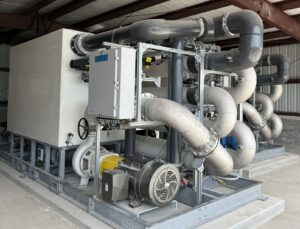
Landfill Leachate Treatment System
A landfill which produces 200,000gpd of leachate needed a new treatment system to be able to discharge to surface water. Dynatec provided a Membrane Bioreactor (MBR) that utilized an existing tank as the bioreactor. A Reverse Osmosis (RO) system was also provided to further purify the MBR permeate prior to discharge. Repurposing existing assets saved the customer significant costs. The MBR conversion was the easiest and most cost-effective method to achieve their treatment goals.
Landfill leachate treatment systems with Membrane Bioreactors (MBR)s have developed many unique process improvements for industrial wastewater applications. Dynatec successfully uses Ultrafiltration (UF), MBR and Reverse Osmosis (RO) for landfill leachate applications.
Landfill leachate treatment system requirements
Treatment can vary, depending on the discharge requirements, and the contaminants present
Landfill leachate is characterized by: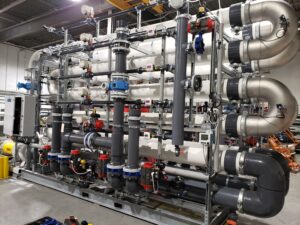
- High Total Dissolved Solids (TDS)
- Heavy metals
- High BOD
- Color
- High COD
- High ammonia
Landfill leachate treatment systems options
The MBR option: an aerated biological mixed liquor process operating at very high solids concentrations.
The advantages are:
- Long sludge age produces a well acclimated biomass. High concentration (typically 12,000 to 20,000 mg/l) provides very high rates of reaction
- Excellent nitrification and de-nitrification
- Smaller footprint then conventional aerated systems
- High-quality effluent as a result of using membranes for final clarification
- Lower sludge production than conventional systems
Alternative landfill leachate treatment options:
- Chemical precipitation of metals before MBR treatment
- RO after MBR treatment removes organic and inorganic contaminants, and color
- UF followed by RO
The two effluent streams from a RO system are:
- Permeate
- Concentrate (or reject)
This can be re-injected into the landfill. Its long-term effects on leachate concentrations should be considered.
Conclusion
The MBR process provides the highest possible levels of organic removal with essentially zero suspended solids in the effluent. This is the ideal feed system for RO treatment.
RO permeate can be used for other non-potable purposes:
For more information on landfill leachate treatment systems, please contact Dynatec.
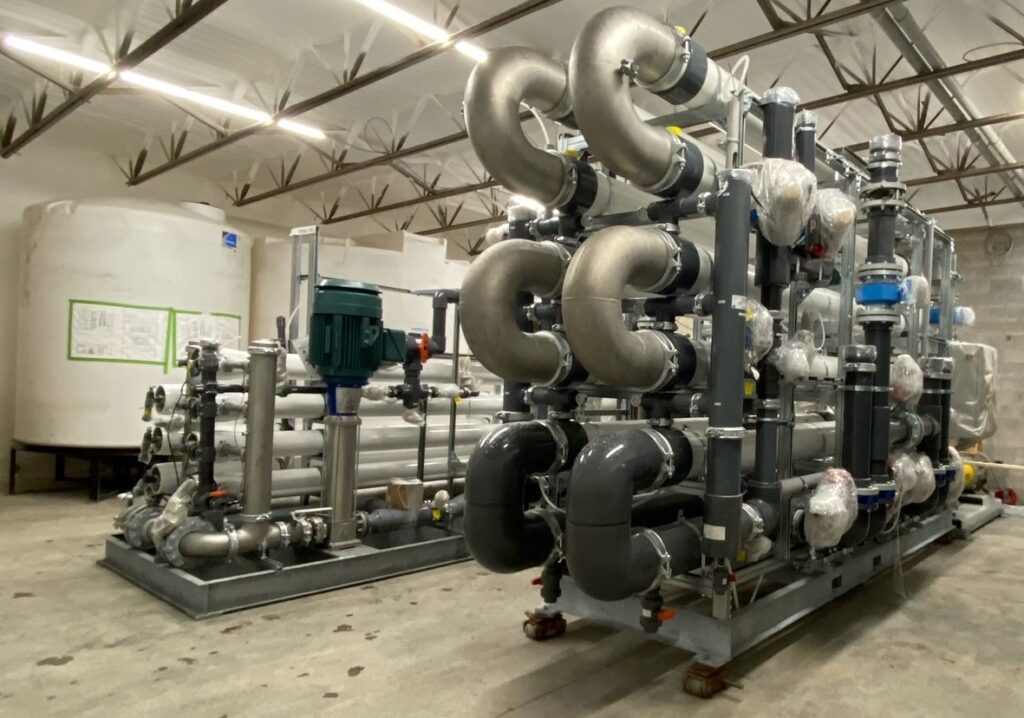
https://www.dynatecsystems.com/industries/landfill-leachate-treatment/
Poultry Processing Plant MBR
Dynatec Systems’ installed a HiBrid™ UF for MBR service at a poultry processing plant that processes 800,000 gallons per day. The Membrane Bioreactor (MBR) operates at high flux which means less membrane surface area is required and ultimately saving capital cost. Dynatec Systems has installed over 600 membrane systems providing wastewater solutions since 1979. The HiBrid™ MBR UF combines sound engineering and effective process design with state-of-the-art materials of construction.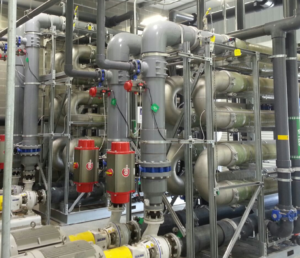
Outsource your wastewater service! Dynatec will design-build-own-operate-maintain (DBOOM) your wastewater treatment plant allowing you to concentrate on your core business.
The industrial MBR is the ideal bioreactor configuration for treatment of organic or inorganic contaminants present in industrial wastewaters. MBR’s operate at a higher efficiency while achieving consistent design performance objectives. This makes MBR a more cost effective method of industrial wastewater treatment when performance and tank requirements are considered.
Industrial Membrane Bioreactors Benefits:
- Higher flux
- Lower costs
- Better membranes
- Improved permeate quality
- Less operator attention and maintenance
Industrial Membrane Bioreactor (MBR) Applications
Dynatec’s industrial MBR is the ideal biological system for industrial wastewater treatment. It is designed to handle high strength wastewater containing high concentrations of:
- Biochemical Oxygen Demand (BOD)
- Chemical Oxygen Demand (COD)
- Oil & Grease (FOG)
- Volatiles
- Metals
- Ammonia
- Nitrate
- Inorganic
The performance is not affected by changes in sludge settleability like the conventional systems, making it the wise choice for industrial wastewater treatment systems that have difficult-to-treat waste streams. Dynatec’s MBRs can effectively handle industrial wastewater streams that would otherwise be toxic or inhibitory to other biological treatment systems.
Backed by decades of experience with MBRs, Dynatec has developed many unique process solutions necessary for industrial wastewater treatment applications such as:
- Landfill leachate
- Hazardous landfill leachate with metals removal
- Automotive manufacturing wastewater
- Food manufacturing wastewater
- Titanium processing wastewater
Contact Dynatec Systems today to discuss your wastewater solutions.
https://www.dynatecsystems.com/industries/food-and-beverage/poultry-processing-wastewater-treatment/
